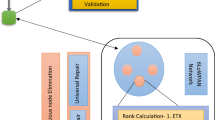Abstract
Internet Engineering Task Force (IETF) has recommended the use of routing protocol for Low Power and Lossy Network (RPL) for Internet Protocol version 6 (IPv6) enabled Internet of Things. However, RPL is vulnerable to internal and external attacks in a network. A malicious node in a rank attack, which is consumed by its child nodes, advertises false rank information. This consequently causes the selection of a malicious node as preferred parent for routing information to the sink node. Given the widespread application of RPL protocol in smart homes, smart cities, and the smart world, it is imperative to address this problem. In this paper, a novel Sink-based intrusion detection system (SBIDS) for the detection of rank attack in RPL is presented. SBIDS has less computational overhead as all detection processes take place at the sink node, which saves network resources. Through a comprehensive simulation analysis, it is shown that the proposed SBIDS provides high detection rate.












Similar content being viewed by others
References
Atzori L, Iera A, Morabito G (2010) The Internet of Things: a survey. Comput Netw 54(15):2787–2805
Whitmore A, Agarwal A, Da Xu L (2015) The Internet of Things: a survey of topics and trends. Inf Syst Front 17(2):261–274
Da Xu L, He W, Li S (2014) Internet of things in industries: a survey. IEEE Trans Ind Inform 104:2233–2243
Chen, T-Yi, et al (2013) A IoT application of safe building in IPv6 network environment. computer software and applications conference (COMPSAC), 2013 I.E. 37th Annual. IEEE, pp 748–753
Ruan DX, Wu D, Wu XB (2012) The Internet of things technology in logistics application: stages, trend and drive modes. Management of Technology (ISMOT), 2012 International Symposium on IEEE, pp 452–455
Clausen T, Herberg U, Philipp M (2011) A critical evaluation of the IPv6 routing protocol for low power and lossy networks (RPL). wireless and mobile computing, networking and communications (WiMob), 2011 I.E. 7th international conference on. IEEE
Winter T, Thubert P (2010) RFC 6550: RPL: IPv6 routing protocol for Low-Power and Lossy Networks, Internet Engineering Task Force (IETF) Request For Comments, March
Dvir A, Holczer T, Buttyan L (2011) VeRA-version number and rank authentication in rpl. Mobile Adhoc and sensor systems (MASS), 2011 I.E. 8th International Conference on. IEEE
Raza S, Shahid LW, Voigt T (2013) SVELTE: real-time intrusion detection in the Internet of Things. Ad Hoc Netw 11(8):2661–2674
Ali H (2012) A performance evaluation of RPL in Contiki: a Cooja simulation based study, Master Thesis Blekinge Institute of Technology, School of Computing
Levis P, Clausen T, Hui J, Gnawali O, Ko J (2011) RFC 6206: the trickle algorithm draft-ietf-roll- trickle-08, Internet Engineering Task Force (IETF) Request For Comments, Jan
Mayzaud A, Badonnel R, Chrisment I (2016) A taxonomy of attacks in RPL-based Internet of Things. Int J Netw Secur 18(3):459–473
Pongle P, Chavan G (2015) A survey: attacks on RPL and 6LoWPAN in IoT. Pervasive computing (ICPC), 2015 International Conference on. IEEE,. pp 0–5
Wallgren L, Raza S, Voigt T (2013) Routing attacks and countermeasures in the RPL-based internet of things. Int J Distrib Sens Netw 9(8):794326
Le A, Loo J, Luo Y, Lasebae A (2013) The impacts of internal threats towards routing protocol for low power and lossy network performance, IEEE Symposium Computer and Communications (ISCC), pp 789–794
Landsmann M, Wahlisch M, Schmidt T (2013) Topology authentication in RPL. computer communications workshops (INFOCOM WKSHPS), 2013 I.E. conference on. IEEE, pp 73–74
Heiner P, et al (2013) TRAIL: topology authentication in RPL. arXiv preprint arXiv:1312.0984
Anhtuan L, et al (2011) Specification-based IDS for securing RPL from topology attacks. Wireless Days (WD), 2011 IFIP. IEEE, pp 4–6
Takumi M, Toyoda K, Sasase I (2015) Low false alarm attacker’s detection in RPL by considering timing inconstancy between the rank measurements. IEICE Commun Express 4(2):44–49
Weekly K, Pister K (2012) Evaluating sinkhole defense techniques in RPL networks. Network protocols (ICNP), 2012 20th IEEE International Conference on. IEEE
Iuchi K et al (2015) Secure parent node selection scheme in route construction to exclude attacking nodes from RPL network. IEICE Commun Express 4(11):340–345
Zhang L, Feng G, Qin S (2015) Intrusion detection system for RPL from routing choice intrusion. Communication Workshop (ICCW), 2015 I.E. International Conference on. IEEE, pp 2652–2658
Sebastian S, et al (2013) Towards a trust computing architecture for RPL in cyber physical systems. Network and service management (CNSM), 2013 9th International Conference on. IEEE, pp 134–137
Anthea M, Badonnel R, Chrisment I (2017) A distributed monitoring strategy for detecting version number attacks in RPL-based networks. IEEE Trans Netw Serv Manag
Karthik VK, Pushpalatha M (2017) Addressing attacks and security mechanism in the RPL based IOT. Int J Comput Sci Eng 5(5):1715–1721
Airehrour D, Gutierrez J, Ray SK (2016) Securing RPL routing protocol from blackhole attacks using a trust-based mechanism. Telecommunication Networks and Applications Conference (ITNAC), 2016 26th International. IEEE
Glissa G, Rachedi A, Meddeb A (2016) A secure routing protocol based on RPL for Internet of Things. Global Communications Conference (GLOBECOM), 2016 IEEE. IEEE
Kamble A, Malemath VS, Patil D (2017) Security attacks and secure routing protocols in RPL-based Internet of Things: survey. Emerging Trends & Innovation in ICT (ICEI), 2017 International Conference on IEEE
Lee KC, et al (2012) RPL under mobility. Consumer Communications and Networking Conference (CCNC), 2012 IEEE. IEEE
Adam D et al (2011) Powertrace: network-level power profiling for low-power. Wirel Netw
Acknowledgments
The authors would like to thank Higher Education Commission of Pakistan, COMSATS Institute of Information Technology, and Bahria University Islamabad, for their continuous support for our research.
Author information
Authors and Affiliations
Corresponding author
Rights and permissions
About this article
Cite this article
Shafique, U., Khan, A., Rehman, A. et al. Detection of rank attack in routing protocol for Low Power and Lossy Networks. Ann. Telecommun. 73, 429–438 (2018). https://doi.org/10.1007/s12243-018-0645-4
Received:
Accepted:
Published:
Issue Date:
DOI: https://doi.org/10.1007/s12243-018-0645-4




